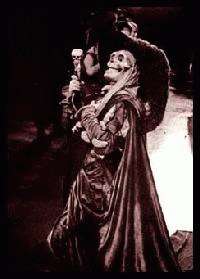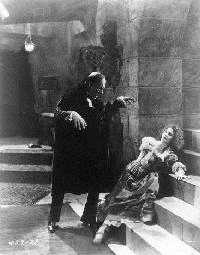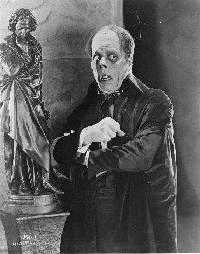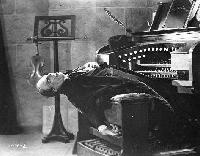


Monday, 17th JUNE 2002
MASKERADE!!! |
featuring:
THE PHANTOM OF THE OPERA (1925)
Phantom Of The Opera is my all-time favorite Chaney film. His Erik is a classic figure of tragedy & terror. We all know the story & remember the unmasking scene, but I get chills when I watch it to this day. Mary Philbin (Christine) creeps up on the Phantom while he’s playing his organ (the musical piece he is playing is about a famous lover of life & women, "Don Juan Triumphant") & reaches for the mask. His body tenses, she pulls back…then Christine goes in for the goal. The camera, which has been filming from the side, suddenly jumps to front as the mask is pulled off, revealing the ruined skull-like face underneath. Robert Bloch (author of Psycho) describes that moment as "the naked face of horror." Brilliant. The faces of both are on screen at the same time. In a matter of moments, Erik’s face goes from shock &surprise to rage and horror, Christine meanwhile is still smiling, hopeful that this man will be the handsome angel she imagines, but is quickly overcome by disbelief & fear. It’s a beautiful moment. |
 |
|
It is not just the figure of the mysterious music-lover that haunts the story of The Phantom of the Opera but also that of the remarkable American film star, Lon Chaney Snr., for more than anyone else he created the image most readily associated in the public mind with the tale - that of the disfigured man skulking through the labyrinths of l'Opéra masterminding the career of his beautiful protégée. Indeed, it is arguable that if Chaney, the Man of a Thousand Faces, hadn’t starred in the hugely influential 1925 silent movie, Gaston Leroux's story might have remained in obscurity instead of inspiring a whole series of screen & stage adaptations during the past half century. With that film, Chaney not only made himself an international star but placed the story of The Phantom of the Opera firmly alongside those other great horror classics, Dracula & Frankenstein. |
 |
| The moment when Chaney snatched away the mask from his famous Death's Head also provided one of the great moments of screen history, (reportedly causing many people among the early audiences to faint!) as well as setting a standard for all who have since played the role. Although the former stage manager turned actor was always reluctant to reveal just how he achieved his terrifying appearance, he firmly denied wearing any kind of mask: "It was the use of paints in the right shades & the right places - not the obvious parts of the face - which gave the complete illusion of horror," Chaney said. The second version made in 1943, this time with sound & in color, starred Claude Raines as a revengeful Phantom who had been scarred by acid. Interestingly, all the sets for the original Chaney picture were used in this remake & the photography won an Oscar. |
 |
| Twenty years on, Leroux's story was shabbily treated in a Spanish version, El Fantasma de la Operetta, which portrayed the Phantom as a blood-thirsty villain bent on murdering chorus girls. Two years later, in 1962, Hammer Pictures revamped it as one of their series of 'Hammer Horrors' with Herbert Lom & Heather Sears. Most recently, the original concept was abandoned in The Phantom of the Paradise (1974) when the Paris Opera House became a New York rock 'n' roll theater, & the Phantom a demented disc jockey preying on pretty teeny-boppers! The story has not fared much better on the stage.In France, strangely, it has scarcely appealed to dramatists at all, & there have only been two notable productions in England. The first was a much abridged version performed as part of a Grand Guignol season at the Little Theatre in London in 1935 & then, in 1975, the Actors Company mounted a performance with Edward Petherbridge in the title role & Sharon Duce as Christine. It is also a sad fact that the image of the Phantom has obscured Gaston Leroux himself - for few people knew his name & even fewer have read his books. Yet, just as this new production will further ensure the continuation of the legend, it might perhaps help rescue his creator from the wings of literary acclaim where he has stood for so long. |
 |
DAISY: STORY OF A FACELIFT (1982)
In a probing yet playful approach to a sensitive subject, this documentary examines the values that prompt people to alter their looks through cosmetic surgery. Personal accounts of men & women, young & old, who have decided to change their bodies are counterbalanced by comments from professionals who explain the effects of physical appearance on our lives. The film focuses mainly on the experiences of Daisy de Bellefeuille, a frank & feisty woman who decides to counter middle age with a facelift. The film provides us with a front-row seat during a facelift operation, as well as a close-up look at the results. Also available in French- Daisy : le dilemme d'une chirurgie esthétique. Director Michael Rubbo Producer Michael Rubbo, Adam Symansky, Giles Walker Images Susan Trow Editor Michael Rubbo Sound André Galbrand, Hans Peter Strobl, Claude Hazanavicius Producers National Film Board of Canada. 57 min 43 s
|
 |
MORE SPLODGY INFO
BACK TO THE VAULT
SPLODGE! HOMEPAGE |







